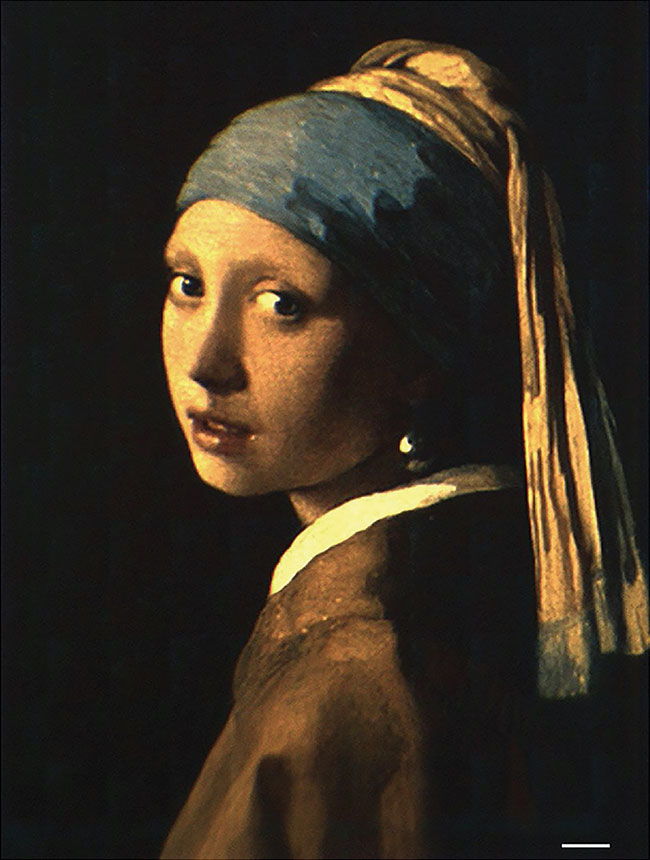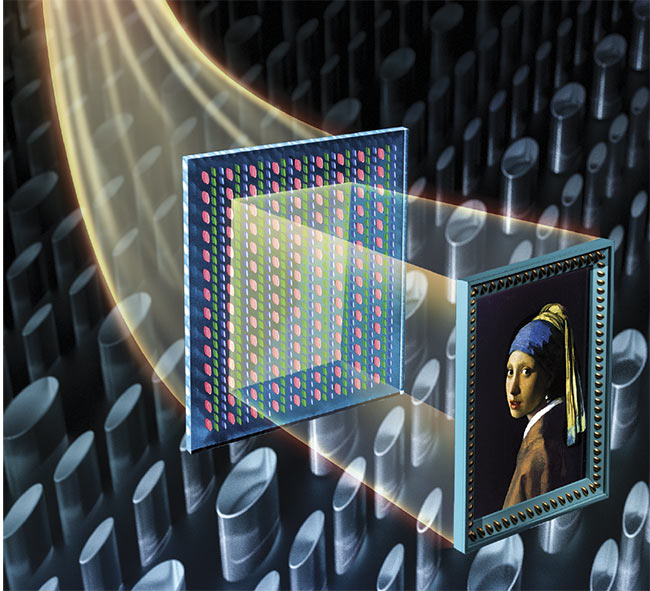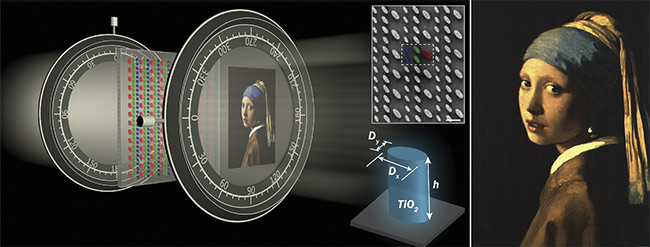In fine art, the “conversation of contrasts” between the use of light and dark is called chiaroscuro. The technique was
a signature style of Dutch painter Johannes Vermeer’s. It creates a dramatic depth that was achieved by researchers from the U.S. National Institute of Standards and Technology (NIST) and Nanjing University in China — in a 1- × 1-mm square reproduction of “Girl with a Pearl Earring.” By shining polarized white light over a glass slide topped with millions of tiny nanopillars, the collaborators expressed Vermeer’s subtle shades, even the texture of his oil paint. Their success has implications for improving optical communications and anti-forgery technology.



A 1-mm-sq reproduction of Johannes Vermeer’s ‘Girl with a Pearl Earring’ was re-created using millions of nanopillars, whose placement and rotation affected both color and intensity. Scale bar = 500 nm. Courtesy of Ting Xu/Nanjing University.
While “painting” with nanostructures is not new, until now scientists have been unable to adjust the intensity or brightness of colors trapped and emitted by nanopillars.
Why Vermeer? The researchers from NIST and Nanjing University specifically selected the Dutch master’s work for testing their new method because of Vermeer’s signature style of using light. To re-create his masterpiece in miniature, they crafted arrays of 600-nm-high pillars, each with an elliptical cross section. This enabled them to position the pillars so that, depending on their location on the slide, their rotations would affect the polarization of the incoming light, thus changing the light’s brightness. According to Amit Agrawal, one of the NIST researchers, the team selected titanium dioxide as the building material because of its low loss and high refractive index
in the visible range.
To re-create Vermeer’s painting, five nanopillars — one red, two green, and two blue — together generated the color of one pixel on a digital image. Starting
with a proportionate digital version of the portrait, the researchers assigned rotations to each pillar based on the RGB pixel data. To create a full image using this method, millions of pillars were needed to represent every color in the painting accurately.
Agrawal said nanotechnologists have been steadily expanding the range of colors they can express with nanopillars. The design of the microscopic pillars follows the influence of structural coloration that happens in nature, such as on butterfly
wings or bird feathers, in which the surface interferes with light, changing the colors that we see. But altering the brightness of the colors needed to reproduce the painting, and therefore the whole dynamic of the end result, required another component: a special polarizing filter.
The team placed a filter on the back of the glass slide that prevented the passage of light, whose polarization remained unchanged in its journey over the pillars. In this way, a pillar without a rotation relative to the light source projected a dark spot, while different rotation angles resulted in different intensities. And just like that — chiaroscuro.
“We did not expect that this painting was going to look this beautiful,” said Agrawal of the Vermeer reproduction, which took over an hour to create using the nanopillars. The miniature version features the same depth and contrasts
that the artist originally created in his 44.5- × 39-cm oil painting.
Vermeer is also known for his use of expensive pigments — such as ochre,
vermillion, and ultramarine — to capture the darkest darks and the brilliant lights that make his work so notable. Now that nanotechnologists have learned how to
create structural color with optical intensity, applications for their work will continue to become more detailed. For example, this approach could be used to create currency with designs so intricate that they are difficult to counterfeit. And in optical communications, the ability to control the intensity of light carried through fiber optics could improve how and in what quantities information is transmitted.